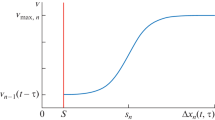Abstract
In this paper, we propose a dynamic stochastic differential model for describing traffic flow based on the Markov chain theory. A key feature of our approach is considering vehicle arrivals and departures, which results in the total number of vehicles in the system varying over time. This makes our proposed transport system dynamic and more realistic. By theoretically and numerically analyzing a simplified model with two speed states, we show our dynamic model obtains accurate fitted values for predicting traffic flow. Analytic solutions for both speed states and the expected values of traffic flow are obtained. By using traffic flow data from the I-80 Freeway Dataset from the NGSIM program, we make predictions on traffic flow and compare our predictions with those of existing approaches. The results show that our proposed approach provides more accurate predictions of traffic flow; thus, dynamic terms are of great significance in constructing traffic flow models.



Similar content being viewed by others
References
Anda C, Fourie P, Erath A (2016) Transport modelling in the age of big data. Singapore ETH Centre, Singapore
Castillo E, Menéndez JM, Sánchez-Cambronero S (2008) Improved Magnus’s form approximation of saturation vaporpressure. Transport Res B Methodol 42(5):482–509
Chandrasekar P (2015) Big data and transport modelling: opportunities and challeges. Int J Appl Eng Res 10(17):38038–38044
Chen D, Laval J, Zheng Z, Ahn S (2012) A behavioral car-following model that captures traffic oscillations. Transport Res B Methodol 46(6):744–761
Costeseque G, Lebacque LP (2014) A variational formulation for higher order macroscopic traffic flow models: numerical investigation. Transport Res B Methodol 70(12):112–133
Dimitriou L, Tsekeris T, Stathopoulos A (2008) Adaptive hybrid fuzzy rule-based system approach for modeling and predicting urban traffic flow. Transport Res Part C 16(5):554–573
Du L, Peeta S, Yong HK (2012) An adaptive information fusion model to predict the short-term link travel time distribution in dynamic traffic networks. Transport Res Part B 46(1):235–252
Galatioto F, Giuffrè T, Bell M, Tesoriere G, Campisi T (2012) Traffic microsimulation model to predict variability of red-light running influenced by traffic light operations in urban area. Procedia Soc Behav Sci 53(4):872–880
Haghani M, Shahhoseini Z, Sarvi M (2016) Path sets size, model specification, or model estimation: which one matters most in predicting stochastic user equilibrium traffic flow? J Traffic Transport Eng 3(3):181–191
Halkias J, Colyar J (2006) NGSIM Interstate 80 Freeway Dataset, FHWA-HRT-06-137. US Federal Highway Administration, Washington, DC
Hassan HM, Abdel-Aty MA (2013) Predicting reduced visibility related crashes on freeways using real-time traffic flow data. J Saf Res 45(6):29–36
Huang K (1987) Statistical mechanics. Wiley, New York
Kwoczek S, Martino SD, Nejdl W (2014) Predicting and visualizing traffic congestion in the presence of planned special events. J Visual Lang Comput 25(6):973–980
Laval JA (2011) Hysteresis in traffic flow revisited: an improved measurement method. Transport Res B Methodol 45(2):385–391
Li J, Zhang HM (2013) The variational formulation of a non-equilibrium traffic flow model: theory and implications. Transport Res Part B Methodol 57(11):314–325
Li D, Liu Z, Liu C, Liu B, Zhang W (2012) Reasoning-predicting model based on strong relevant logic in road traffic forecasting. Phys Procedia 33(6):1105–1110
Lin L, Wang Q, Sadek AW (2016) A combined M5P tree and hazard-based duration model for predicting urban freeway traffic accident durations. Accid Anal Prev 91:114–126
Ratrout NT, Gazder U, El-Alfy ESM (2014) Effects of using average annual daily traffic (AADT) with exogenous factors to predict daily traffic. Procedia Comput Sci 32:325–330
Sheu JB, Wu HJ (2015) Driver perception uncertainty in perceived relative speed and reaction time in car following a quantum optical flow perspective. Transport Res B Methodol 80(10):257–274
Siqueira AF, Peixoto CJT, Wu C, Qian WL (2016) Effect of stochastic transition in the fundamental diagram of traffic flow. Transport Res B Methodol 87(5):1–13
Wiyono S (2012) The application of traffic simulation model to predict initiation and progression of crack for flexible pavements. Procedia Soc Behav Sci 43(5):813–818
Xu XF, Zhang W, Li N, Xu H (2015) A bi-level programming model of resource matching for collaborative logistics network in supply uncertainty environment. J Franklin Inst 352(9):3873–3884
Yin Y, Shang P (2016) Forecasting traffic time series with multivariate predicting method. Appl Math Comput 291:266–278
Zhang HM (2001) New perspectives on continuum traffic flow models. Netw Spat Econ 1(1):9–33
Zhou XY, Schmidt F, Toutlemonde F, Jaco B (2016) A mixture peaks over threshold approach for predicting extreme bridge traffic load effects. Probab Eng Mech 43:121–131
Author information
Authors and Affiliations
Corresponding author
Rights and permissions
About this article
Cite this article
Su, Y., Sun, W. Dynamic differential models for studying traffic flow and density. J Ambient Intell Human Comput 10, 315–320 (2019). https://doi.org/10.1007/s12652-017-0506-4
Received:
Accepted:
Published:
Issue Date:
DOI: https://doi.org/10.1007/s12652-017-0506-4




